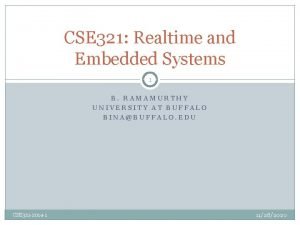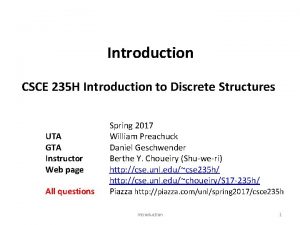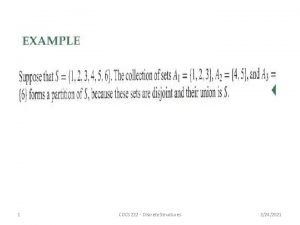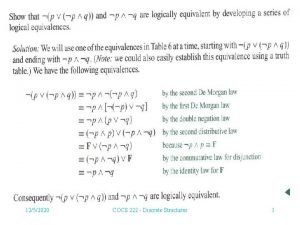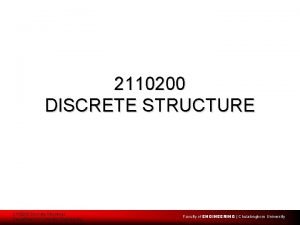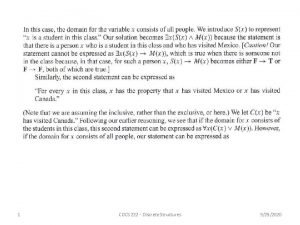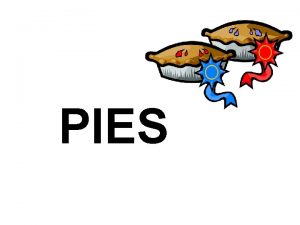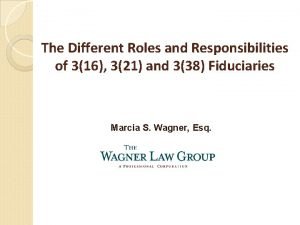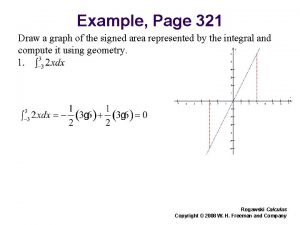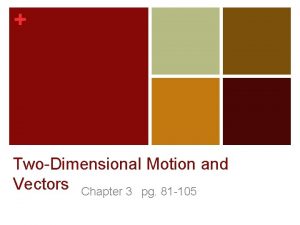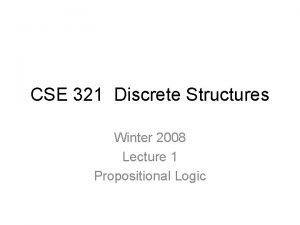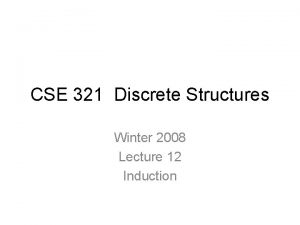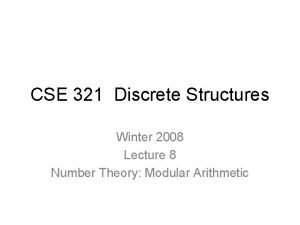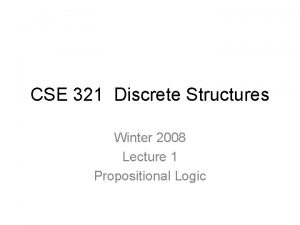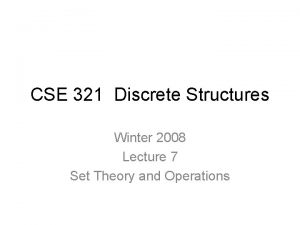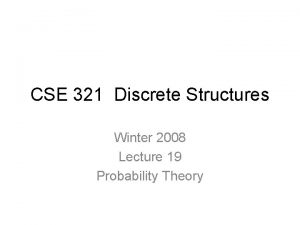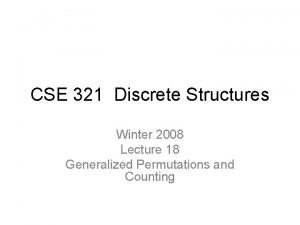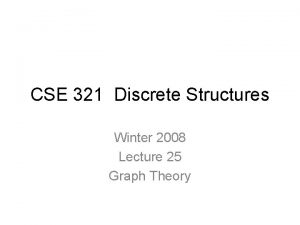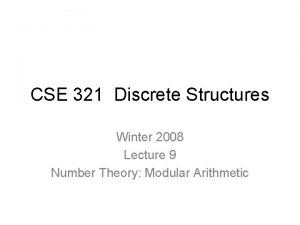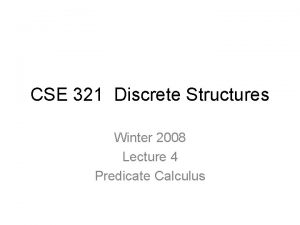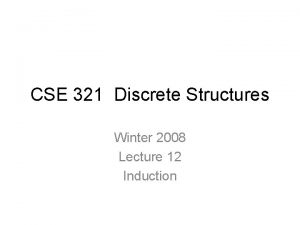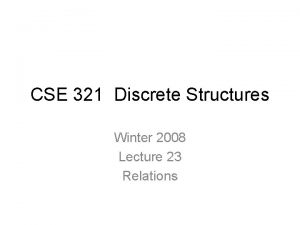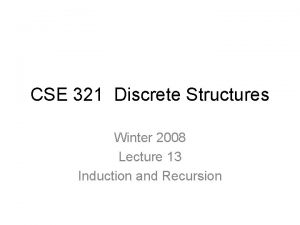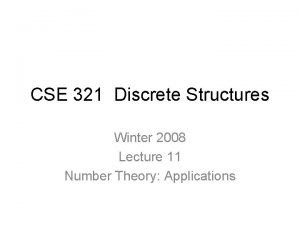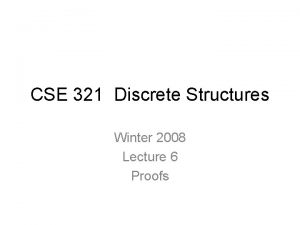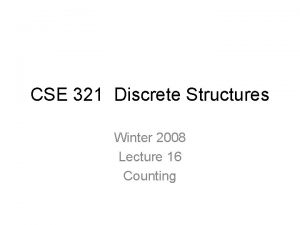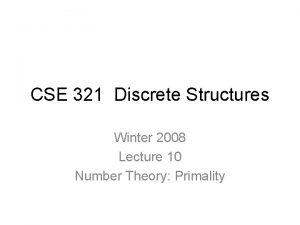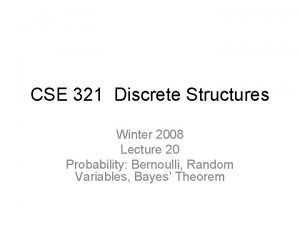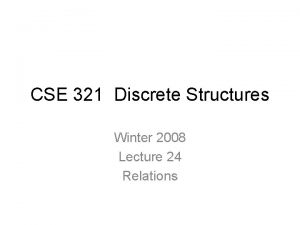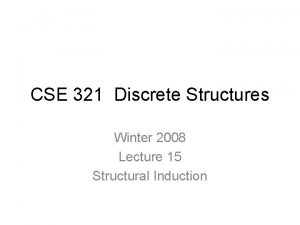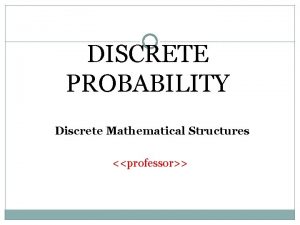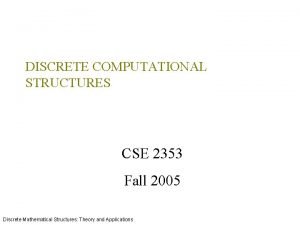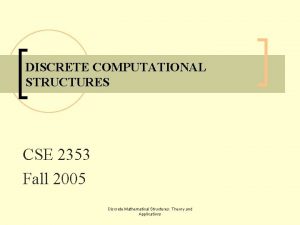CSE 321 Discrete Structures Winter 2008 Lecture 22





























- Slides: 29

CSE 321 Discrete Structures Winter 2008 Lecture 22 Binary Relations

Relations

Definition of Relations Let A and B be sets, A binary relation from A to B is a subset of A B Let A be a set, A binary relation on A is a subset of A A

Relation Examples

Properties of Relations Let R be a relation on A R is reflexive iff (a, a) R for every a A R is symmetric iff (a, b) R implies (b, a) R R is antisymmetric iff (a, b) R and a b implies (b, a) / R R is transitive iff (a, b) R and (b, c) R implies (a, c) R

Combining Relations Let R be a relation from A to B Let S be a relation from B to C The composite of R and S, S R is the relation from A to C defined S R = {(a, c) | b such that (a, b) R and (b, c) S}

Examples (a, b) Parent: b is a parent of a (a, b) Sister: b is a sister of a What is Parent Sister? What is Sister Parent? S R = {(a, c) | b such that (a, b) R and (b, c) S}

Examples Using the relations: Parent, Child, Brother, Sister, Sibling, Father, Mother express Uncle: b is an uncle of a Cousin: b is a cousin of a

Powers of a Relation R 2 = R R = {(a, c) | b such that (a, b) R and (b, c) R} R 0 = {(a, a) | a A} R 1 = R Rn+1 = Rn R

How is Anderson related to Bernoulli?

From the Mathematics Geneology Project Erhard Weigel Gottfried Leibniz Jacob Bernoulli Johann Bernoulli Leonhard Euler Joseph Lagrange Jean-Baptiste Fourier Gustav Dirichlet Rudolf Lipschitz Felix Klein C. L. Ferdinand Lindemann Herman Minkowski Constantin Caratheodory Georg Aumann Friedrich Bauer Manfred Paul Ernst Mayr Richard Anderson

Transitivity and Composition R is transitive if and only if Rn R for all n 1

n-ary relations Let A 1, A 2, …, An be sets. An n-ary relation on these sets is a subset of A 1 A 2 . . . An.

Relational databases Student_Name ID_Number Major GPA Knuth 328012098 CS 4. 00 Von Neuman 481080220 CS 3. 78 Von Neuman 481080220 Mathematics 3. 78 Russell 238082388 Philosophy 3. 85 Einstein 238001920 Physics 2. 11 Newton 1727017 Mathematics 3. 61 Karp 348882811 CS 3. 98 Newton 1727017 Physics 3. 61 Bernoulli 2921938 Mathematics 3. 21 Bernoulli 2921939 Mathematics 3. 54

Alternate Approach Student_ID Name GPA Student_ID Major 328012098 Knuth 4. 00 328012098 CS 481080220 Von Neuman 3. 78 481080220 CS 238082388 Russell 3. 85 481080220 Mathematics 238001920 Einstein 2. 11 238082388 Philosophy 1727017 Newton 3. 61 238001920 Physics 348882811 Karp 3. 98 1727017 Mathematics 2921938 Bernoulli 3. 21 348882811 CS 2921939 Bernoulli 3. 54 1727017 Physics 2921938 Mathematics 2921939 Mathematics

Database Operations Projection Join Select

Representation of relations Directed Graph Representation (Digraph) {(a, b), (a, a), (b, a), (c, d), (c, e) (d, e) } b c a d e

Matrix representation Relation R from A={a 1, … ap} to B={b 1, . . . bq} {(1, 1), (1, 2), (1, 4), (2, 1), (2, 3), (3, 2), (3, 3) }

Matrix operations How do you tell if a relation is reflexive from its adjacency matrix? How do you tell if a relation is symmetric from its adjacency matrix? Suppose R has matrix MR and S has Matrix MS. What are the matrices for R S and R S?

Matrix multiplication Standard ( , +) matrix multiplication. A is a m n matrix, B is a n p matrix C = A B is a m p matrix defined:

And-OR Matrix multiplication A is a m n boolean matrix, B is a n p boolean matrix C = A B is a m p matrix defined:

Matrices and Composition MS R = MR MS R = {(a, a), (a, c), (b, a), (b, b)} S = {(b, a), (b, c), (c, a), (c, c)}

Closures • Reflexive Closure • Symmetric Closure

Transitive Closure • R = {(1, 2), (2, 3), (3, 4)}

Transitive closure

Equivalence Relations Definition: A relation on a set A is called an equivalence relation if it is reflexive, symmetric, and transitive. Are these equivalence relations? • Congruence Mod m on Z+. R = {(a, b) | a b mod m} • The ‘divides’ relation on Z+. R = {(a, b) | a|b}

Equivalence classes • R = {(a, b) | a b mod 3}, Domain: Z+

Partial Orderings Definition: A relation R on a set S is called a partial ordering if it is reflexive, antisymmetric, and transitive. A set S together with a partial ordering R is called a partially ordered set, or poset. Are these posets? • (Z, ≥) • (Z+, |)

Total Orderings Definition: If (S, R) is a poset and every two elements of S are comparable, S is called a totally (linearly) ordered set, and R is called a total (linear) order. Are these posets totally ordered? • (Z, ≥) • (Z+, |)
 Cse 321
Cse 321 2008 2008
2008 2008 Winter kommt winter kommt flocken fallen nieder
Winter kommt winter kommt flocken fallen nieder Winter kommt winter kommt flocken fallen nieder lied
Winter kommt winter kommt flocken fallen nieder lied Winter kommt winter kommt flocken fallen nieder
Winter kommt winter kommt flocken fallen nieder 01:640:244 lecture notes - lecture 15: plat, idah, farad
01:640:244 lecture notes - lecture 15: plat, idah, farad Webhandin unl
Webhandin unl Discrete structures
Discrete structures Discrete computational structures
Discrete computational structures What is tautology in math
What is tautology in math Discrete structures
Discrete structures 2110200
2110200 Discrete structures
Discrete structures Homologous structures example
Homologous structures example 321 principle
321 principle Apokalypsis 321
Apokalypsis 321 Ntp 321
Ntp 321 Pie dough ratio
Pie dough ratio 321 riq
321 riq Ics 321
Ics 321 Responsibilities
Responsibilities 321 draw
321 draw F tag 689
F tag 689 How to activate voice mail in airtel
How to activate voice mail in airtel 321 feedback
321 feedback Oam 321
Oam 321 Ce 321
Ce 321 The royal gorge bridge in colorado rises 321
The royal gorge bridge in colorado rises 321 Ics-321
Ics-321 Csi 321
Csi 321
